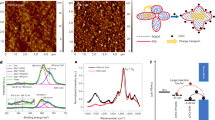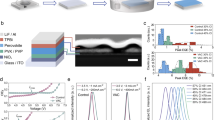Abstract
Electroluminescence efficiencies of metal halide perovskite nanocrystals (PNCs) are limited by a lack of material strategies that can both suppress the formation of defects and enhance the charge carrier confinement. Here we report a one-dopant alloying strategy that generates smaller, monodisperse colloidal particles (confining electrons and holes, and boosting radiative recombination) with fewer surface defects (reducing non-radiative recombination). Doping of guanidinium into formamidinium lead bromide PNCs yields limited bulk solubility while creating an entropy-stabilized phase in the PNCs and leading to smaller PNCs with more carrier confinement. The extra guanidinium segregates to the surface and stabilizes the undercoordinated sites. Furthermore, a surface-stabilizing 1,3,5-tris(bromomethyl)-2,4,6-triethylbenzene was applied as a bromide vacancy healing agent. The result is highly efficient PNC-based light-emitting diodes that have current efficiency of 108 cd A−1 (external quantum efficiency of 23.4%), which rises to 205 cd A−1 (external quantum efficiency of 45.5%) with a hemispherical lens.
This is a preview of subscription content, access via your institution
Access options
Access Nature and 54 other Nature Portfolio journals
Get Nature+, our best-value online-access subscription
$29.99 / 30 days
cancel any time
Subscribe to this journal
Receive 12 print issues and online access
$209.00 per year
only $17.42 per issue
Buy this article
- Purchase on Springer Link
- Instant access to full article PDF
Prices may be subject to local taxes which are calculated during checkout






Similar content being viewed by others
Data availability
The data that support the plots within this paper and other findings of this study are available from the corresponding author on reasonable request.
References
Tan, Z.-K. et al. Bright light-emitting diodes based on organometal halide perovskite. Nat. Nanotechnol. 9, 687–692 (2014).
Kim, Y.-H. et al. Multicolored organic/inorganic hybrid perovskite light-emitting diodes. Adv. Mater. 27, 1248–1254 (2015).
Cho, H. et al. Overcoming the electroluminescence efficiency limitations of perovskite light-emitting diodes. Science 350, 1222–1225 (2015).
Protesescu, L. et al. Nanocrystals of cesium lead halide perovskites (CsPbX3, X = Cl, Br, and I): novel optoelectronic materials showing bright emission with wide color gamut. Nano Lett. 15, 3692–3696 (2015).
Schmidt, L. C. et al. Nontemplate synthesis of CH3NH3PbBr3 perovskite nanoparticles. J. Am. Chem. Soc. 136, 850–853 (2014).
Kim, Y.-H., Cho, H. & Lee, T.-W. Metal halide perovskite light emitters. Proc. Natl Acad. Sci. USA 113, 11694–11702 (2016).
Kim, Y.-H., Kim, J. S. & Lee, T.-W. Strategies to improve luminescence efficiency of metal‐halide perovskites and light‐emitting diodes. Adv. Mater. 31, 1804595 (2019).
Koscher, B. A., Swabeck, J. K., Bronstein, N. D. & Alivisatos, A. P. Essentially trap-free CsPbBr3 colloidal nanocrystals by postsynthetic thiocyanate surface treatment. J. Am. Chem. Soc. 139, 6566–6569 (2017).
De Roo, J. et al. Highly dynamic ligand binding and light absorption coefficient of cesium lead bromide perovskite nanocrystals. ACS Nano 10, 2071–2081 (2016).
Wang, H.-C. et al. High-performance CsPb1−xSnxBr3 perovskite quantum dots for light-emitting diodes. Angew. Chem. Int. Ed. 129, 13838–13842 (2017).
Chiba, T. et al. Anion-exchange red perovskite quantum dots with ammonium iodine salts for highly efficient light-emitting devices. Nat. Photon. 12, 681–687 (2018).
Song, J. et al. Organic–inorganic hybrid passivation enables perovskite QLEDs with an EQE of 16.48%. Adv. Mater. 30, 1805409 (2018).
Park, M.-H. et al. Boosting efficiency in polycrystalline metal halide perovskite light-emitting diodes. ACS Energy Lett. 4, 1134–1149 (2019).
Xu, W. et al. Rational molecular passivation for high-performance perovskite light-emitting diodes. Nat. Photon. 13, 418–424 (2019).
Zhao, X. & Tan, Z.-K. Large-area near-infrared perovskite light-emitting diodes. Nat. Photon. 14, 215–218 (2020).
Yang, Y. et al. Comparison of recombination dynamics in CH3NH3PbBr3 and CH3NH3PbI3 perovskite films: influence of exciton binding energy. J. Phys. Chem. Lett. 6, 4688–4692 (2015).
Stranks, S. D. et al. Recombination kinetics in organic-inorganic perovskites: excitons, free charge, and subgap states. Phys. Rev. Appl. 2, 034007 (2014).
Lin, K. et al. Perovskite light-emitting diodes with external quantum efficiency exceeding 20 per cent. Nature 562, 245–248 (2018).
Xiao, Z. et al. Efficient perovskite light-emitting diodes featuring nanometre-sized crystallites. Nat. Photon. 11, 108–115 (2017).
Zhao, B. et al. High-efficiency perovskite–polymer bulk heterostructure light-emitting diodes. Nat. Photon. 12, 783–789 (2018).
Cao, Y. et al. Perovskite light-emitting diodes based on spontaneously formed submicrometre-scale structures. Nature 562, 249–253 (2018).
Yang, X. et al. Efficient green light-emitting diodes based on quasi-two-dimensional composition and phase engineered perovskite with surface passivation. Nat. Commun. 9, 570 (2018).
Zhao, L. et al. Electrical stress influences the efficiency of CH3NH3PbI3 perovskite light emitting devices. Adv. Mater. 29, 1605317 (2017).
Chen, H. et al. High-efficiency formamidinium lead bromide perovskite nanocrystal-based light-emitting diodes fabricated via a surface defect self‐passivation strategy. Adv. Opt. Mater. 8, 1901390 (2020).
Zhu, H. et al. Screening in crystalline liquids protects energetic carriers in hybrid perovskites. Science 353, 1409–1413 (2016).
Yang, Y. et al. Observation of a hot-phonon bottleneck in lead-iodide perovskites. Nat. Photon. 10, 53–59 (2016).
Zheng, F., Tan, L. Z., Liu, S. & Rappe, A. M. Rashba spin–orbit coupling enhanced carrier lifetime in CH3NH3PbI3. Nano Lett. 15, 7794–7800 (2015).
Rappe, A. M., Grinberg, I. & Spanier, J. E. Getting a charge out of hybrid perovskites. Proc. Natl Acad. Sci. USA 114, 7191–7193 (2017).
Swarnkar, A. et al. Quantum dot-induced phase stabilization of α-CsPbI3 perovskite for high-efficiency photovoltaics. Science 354, 92–95 (2016).
Banerjee, A., Chakraborty, S. & Ahuja, R. Bromination-induced stability enhancement with a multivalley optical response signature in guanidinium [C(NH2)3]+-based hybrid perovskite solar cells. J. Mater. Chem. A 5, 18561–18568 (2017).
Giorgi, G., Fujisawa, J.-I., Segawa, H. & Yamashita, K. Organic–inorganic hybrid lead iodide perovskite featuring zero dipole moment guanidinium cations: a theoretical analysis. J. Phys. Chem. C 119, 4694–4701 (2015).
Jodlowski, A. D. et al. Large guanidinium cation mixed with methylammonium in lead iodide perovskites for 19% efficient solar cells. Nat. Energy 2, 972–979 (2017).
Marco, N. D. et al. Guanidinium: a route to enhanced carrier lifetime and open-circuit voltage in hybrid perovskite solar cells. Nano Lett. 16, 1009–1016 (2016).
Kanno, S., Imamura, Y. & Hada, M. First-principles calculations of the rotational motion and hydrogen bond capability of large organic cations in hybrid perovskites. J. Phys. Chem. C 122, 15966–15972 (2018).
Kakekhani, A., Katti, R. N. & Rappe, A. M. Water in hybrid perovskites: bulk MAPbI3 degradation via super-hydrous state. APL Mater. 7, 041112 (2019).
Yi, C. et al. Entropic stabilization of mixed A-cation ABX3 metal halide perovskites for high performance perovskite solar cells. Energy Environ. Sci. 9, 656–662 (2016).
Travis, W., Glover, E. N. K., Bronstein, H., Scanlon, D. O. & Palgrave, R. G. On the application of the tolerance factor to inorganic and hybrid halide perovskites: a revised system. Chem. Sci. 7, 4548–4556 (2016).
Pham, N. D. et al. Tailoring crystal structure of FA0.83Cs0.17PbI3 perovskite through guanidinium doping for enhanced performance and tunable hysteresis of planar perovskite solar cells. Adv. Funct. Mater. 29, 1806479 (2019).
Deng, Z., Kieslich, G., Bristowe, P. D., Cheetham, A. K. & Sun, S. Octahedral connectivity and its role in determining the phase stabilities and electronic structures of low-dimensional, perovskite-related iodoplumbates. APL Mater. 6, 114202 (2018).
Kakekhani, A. et al. Nature of lone-pair–surface bonds and their scaling relations. Inorg. Chem. 57, 7222–7238 (2018).
Kim, Y.-H. et al. Highly efficient light-emitting diodes of colloidal metal–halide perovskite nanocrystals beyond quantum size. ACS Nano 11, 6586–6593 (2017).
Contreras-García, J. et al. NCIPLOT: a program for plotting noncovalent interaction regions. J. Chem. Theory Comput. 7, 625–632 (2011).
Giannozzi, P. et al. QUANTUM ESPRESSO: a modular and open-source software project for quantum simulations of materials. J. Phys. Condens. Matter 21, 395502 (2009).
Garrity, K. F., Bennett, J. W., Rabe, K. M. & Vanderbilt, D. Pseudopotentials for high-throughput DFT calculations. Comput. Mater. Sci. 81, 446–452 (2014).
Perdew, J. P., Burke, K. & Ernzerhof, M. Generalized gradient approximation made simple. Phys. Rev. Lett. 77, 3865–3868 (1996).
Grimme, S., Antony, J., Ehrlich, S. & Krieg, H. A consistent and accurate ab initio parametrization of density functional dispersion correction (DFT-D) for the 94 elements H–Pu. J. Chem. Phys. 132, 154104 (2010).
Wang, Y. et al. Density functional theory analysis of structural and electronic properties of orthorhombic perovskite CH3NH3PbI3. Phys. Chem. Chem. Phys. 16, 1424–1429 (2014).
Marzari, N., Vanderbilt, D., De Vita, A. & Payne, M. C. Thermal contraction and disordering of the Al(110) surface. Phys. Rev. Lett. 82, 3296–3299 (1999).
Macrae, C. F. et al. Mercury CSD 2.0—new features for the visualization and investigation of crystal structures. J. Appl. Cryst. 41, 466–470 (2008).
Jeong, S.-H. et al. Characterizing the efficiency of perovskite solar cells and light-emitting diodes. Joule 4, 1206–1235 (2020).
Acknowledgements
This work was supported by the National Research Foundation of Korea (NRF) grant funded by the Korea government (MSIT) (NRF-2016R1A3B1908431). A.K., R.B.W., and A.M.R. acknowledge the support of the US Department of Energy, Office of Basic Energy Sciences, under grant no. DE-SC0019281 and also the computational support from NERSC of the DOE. P.T. acknowledges the scholarship from Chinese Scholarship Council (CSC). H.J.B. acknowledges funding from the European Research Council (ERC) under the European Union’s Horizon 2020 research and innovation programme (grant agreement no. 834431) and the Spanish Ministry of Economy and Competitiveness (MINECO) via the Unidad de Excelencia María de Maeztu CEX2019-000919-M and MAT2017-88821-R. A.S., S.N. and R.H.F. acknowledge support from the UKRI Global Challenge Research Fund project, SUNRISE (EP/P032591/1) and UKIERI projects. S.N. acknowledges funding and support from Royal Society-SERB Newton International Fellowship.
Author information
Authors and Affiliations
Contributions
Y.-H.K., S.K. and A.K. equally contributed to this work. Y.-H.K., S.K. and T.-W. L. initiated and designed the study. Y.-H.K. and S.K. performed experiments and analysed data. A.K., R.B.W. and P.T. performed the simulations, analysed data, helped understand the structures and mechanisms behind the great efficiency. J.P., D.-H.K. and S.H.J. helped to analyse the data. H.X. and B.H. performed and analysed magnetic field-dependent characteristics. Y.-H.L. and Y.-W.K. measured and analysed TEM. L.M.-S. and H.J.B. commented on the synthesis of nanocrystals. J.P. (KAIST) and S.Y. performed optical simulation of the devices. A.S., S.N. and R.H.F. performed the PLQE measurements and analysis. A.M.R. and T.-W.L. supervised the study. All authors discussed the results and commented on the manuscript.
Corresponding authors
Ethics declarations
Competing interests
The authors declare no competing interests.
Additional information
Peer review information Nature Photonics thanks the anonymous reviewers for their contribution to the peer review of this work.
Publisher’s note Springer Nature remains neutral with regard to jurisdictional claims in published maps and institutional affiliations.
Supplementary information
Supplementary Information
Supplementary Figs. 1–17, Discussion and Tables 1–6.
Rights and permissions
About this article
Cite this article
Kim, YH., Kim, S., Kakekhani, A. et al. Comprehensive defect suppression in perovskite nanocrystals for high-efficiency light-emitting diodes. Nat. Photonics 15, 148–155 (2021). https://doi.org/10.1038/s41566-020-00732-4
Received:
Accepted:
Published:
Issue Date:
DOI: https://doi.org/10.1038/s41566-020-00732-4
This article is cited by
-
How to improve the structural stabilities of halide perovskite quantum dots: review of various strategies to enhance the structural stabilities of halide perovskite quantum dots
Nano Convergence (2024)
-
Phase dimensions resolving of efficient and stable perovskite light-emitting diodes at high brightness
Nature Photonics (2024)
-
New nanostructure perovskite-based light-emitting diode with superior light extraction efficiency enhancement
Scientific Reports (2024)
-
Valley-centre tandem perovskite light-emitting diodes
Nature Nanotechnology (2024)
-
Exciton engineering of 2D Ruddlesden–Popper perovskites by synergistically tuning the intra and interlayer structures
Nature Communications (2024)



